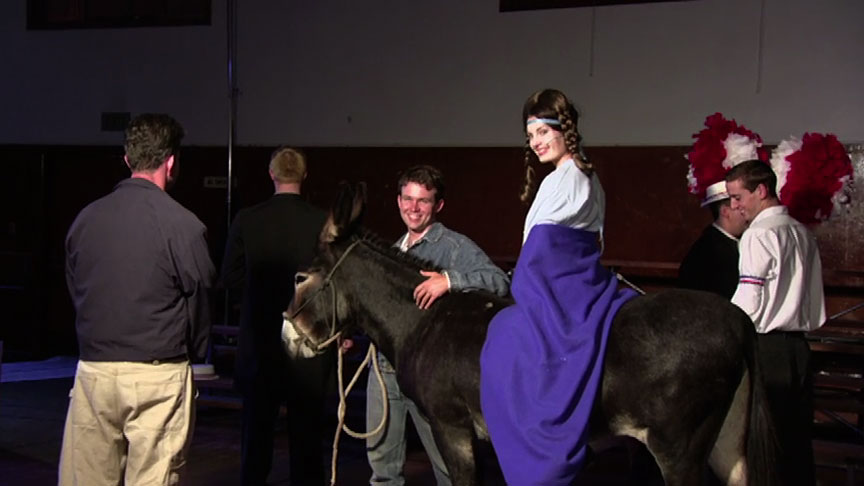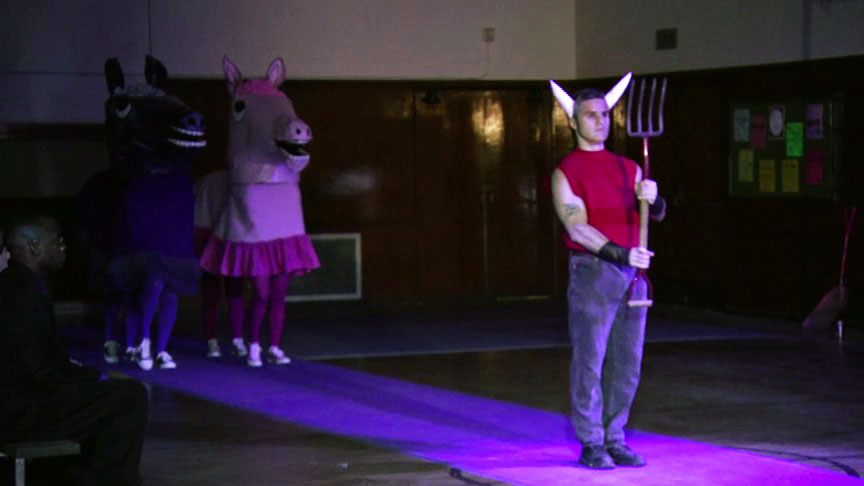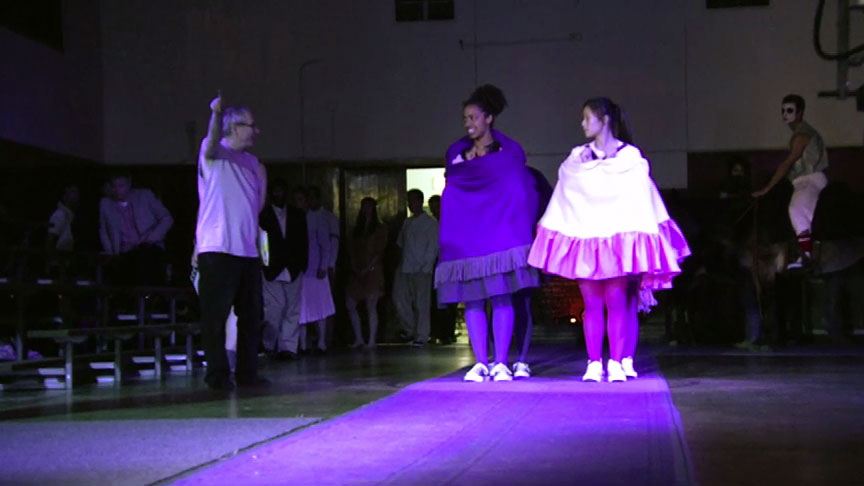Interview
“Day Is Done”

On the set of Final Procession from Day Is Done (2005), Valley Plaza Recreation Center, North Hollywood, 2004. Production still from the Art in the Twenty-First Century Season 3 episode, Memory. © Art21, Inc. 2005.
Artist Mike Kelley discusses his project Day is Done, a performance/video which consists of 365 tapes, one for every day of the year.
ART21: Explain the concept behind your project, Day is Done.
KELLEY: I’m making all these videos based on very common American performance types. You know, school plays, children’s performances, Halloween, dress-up day at work—things like that. But then I’m reconfiguring them through the tropes of history, like the avant-garde. In this one, this soundtrack lets you see the performance tropes more clearly because it de-contextualizes them, to a certain degree. By putting this wrong kind of music to it, you can see a performance type. So, I’m trying to play with popular or folk forms and reveal their structures—their performative structures.
ART21: And how does this relate to your earlier work?
KELLEY: Day is Done is built around the mythos that relates to Educational Complex and the history of a kind of Symbolist attempt at uniting all the arts. Educational Complex is a model of every school I ever went to, plus the home I grew up in, with all the parts I can’t remember left blank. They’re all combined into a new kind of structure that looks like a kind of modernist building. I started to think about this structure through the Gesamtkunstwerk, the “total artwork” of Rudolf Steiner, where he tries to combine all the arts and develop a kind of rule system according to which every art form is related. So, the architecture relates to the dance relates to the music relates to the writing. But it’s also a kind of religion. And so, my religion for this structure is repressed memory syndrome. The idea is that anything you can’t remember, that you forget or block out, is the byproduct of abuse; and that all of these scenarios are supposed to be filling in the missing action in these blank sections in this building. It’s a perverse reading of [Hans Hoffman’s] push-pull theory.

Mike Kelley. Educational Complex, 1995. Synthetic polymer, latex, foam core, fiberglass and wood; 51 × 192 × 96 inches. Whitney Museum of American Art, New York; Purchase, with funds from the Contemporary Painting and Sculpture Committee 96.50. Photo by Geoffrey Clements, photograph copyright © 1998: Whitney Museum of American Art, New York.
ART21: What is your source material for Day is Done?
KELLEY: All the scenarios for Day is Done are based on images found in high-school yearbooks, in this particular case, though I’ve also done a whole collection of similar kinds of images from the small-town newspaper of the town where I grew up. The particular categories had religious ritual overtones, but outside of the church context. They all looked like they were done in public places, or they had gothic overtones. So I said, “Okay, I’m going to work with these particular groups of images and develop a kind of pseudo-narrative flow.” The rituals run the gamut from something like dress-up day at work to St. Patrick’s Day or Halloween, to a community play or an awards ceremony. So, all I have is this image, and then I have to write a whole scenario for it, like a play, and then do the music and everything. Each one is just based on the look of the photograph that tells me what style it has to be done in.
ART21: Why use high-school yearbooks?
KELLEY: It’s not because I have any interest in high school or high-school culture, but it’s one of the few places where you can find photographs of these kinds of rituals. The only other place would be personal snapshots, which aren’t accessible. So, really the only place I could get pictures of these kinds of common American folk rituals are in yearbooks and local newspapers.
ART21: It’s almost like working as an anthropologist.
KELLEY: Yes, I think of it very much that way.

On the set of Final Procession from Day Is Done (2005), Valley Plaza Recreation Center, North Hollywood, 2004. Production still from the Art in the Twenty-First Century Season 3 episode, Memory. © Art21, Inc. 2005.
ART21: Will Day is Done be seen as video work?
KELLEY: My dream is to perform it live in a twenty-four-hour period. So, the day stands for the year. And at midnight, there would be a grand finale spectacle: a donkey basketball game. Because I think the donkey basketball game is one of the greatest examples of American carnival. It’s all about inversions of power, which is very typical of folk forms that perform carnivalesque functions—where you get to break the mold of how you’re supposed to act or look. In that sense, it’s analogous to the traditional social role of art in the avant-garde, but it’s a very restrained one. And I’m just trying to show that relationship between the traditional avant-garde and the carnivalesque social function of these folk rituals, as I guess you’d call them.
ART21: How do you expect viewers to respond to this work?
KELLEY: I know that people don’t look at art like that, and I don’t expect people to know any of this stuff. And I don’t care if they do or don’t, because you have to make an artwork so it can be enjoyed on the most surface level. But I want for the more dedicated art viewer to be able to get the secondary and third levels of meaning. It has to operate on multiple levels: it has to be available to the laziest viewer on a certain level, and then on a more sophisticated level as well.
ART21: Can you say more about the overall structure of Day is Done—how the various scenes work together or compliment each other?
KELLEY: I was thinking of the Russian composer Scriabin who, at the time of his death, was working on a grand spectacle that would last for a week. And there was a different thing for each day, and that was linked to some kind of broader natural system. I’m using the year (a series of 365 tapes) just as a given system, the rationale tying it to this history of works that relate to natural cycles, like Symbolist artworks. But I don’t expect to get to 365. I’d like to get to at least fifty of them. I would like to present one of these late-nineteenth or early-twentieth-century Symbolist works as a live theater work, like the mass spectacles of Meyerhold, or Rudolf Steiner, or even Wagner.

Mike Kelley on the set of Final Procession from Day Is Done (2005), Valley Plaza Recreation Center, North Hollywood, 2004. Production still from the Art in the Twenty-First Century Season 3 episode, Memory. © Art21, Inc. 2005.
ART21: Or like a Passion play?
KELLEY: It’s very much like a Passion play, yes. Passion plays can be folk drama, allegory, and social allegories; they can operate on multiple levels like that. The basic premise is that it’s all based on trauma culture, and that’s a contemporary motivation, like a basic motivational idea. And I have to undermine that. I think having something be somewhat ridiculous is a way of undermining that notion—that life is just about trauma. This is also something that is very much embedded in a lot of modernist work—expressionism and existentialist artworks—that kind of heavy artist-as-sufferer . . . I have no interest in that.
ART21: Do you find this project humorous?
KELLEY: I think that’s the joyfulness of it. But then, it’s a black humor; it’s a mean humor, so it’s a critical joy. You know, it’s negative joy. (LAUGHS) But that’s art, I think—for me, at least. That’s what separates it from the folk art that I’m going to. I think the social function of art is that kind of negative aesthetic. Otherwise, there’s no social function for it. You don’t need art, then. Television can do the same thing.
ART21: And how does the idea of repressed memories syndrome come into play with Day is Done?
KELLEY: It’s hard to differentiate between personal memory and cultural memory because, for example, a lot of what I use in writing is associative, and it comes from my own experience. But it’s very hard to, say, disentangle memories of films or books or cartoons or plays from real experience. It all gets mixed up. So in a way, I don’t make such distinctions, and I see it all as a kind of fiction. And if you read a lot about the literature of repressed memory syndrome, the abuse scenarios are often very standardized. It’s really a form of literature that’s internalized and then voiced as reality. But it finds form in a variety of tropes. So, if you have a religious orientation, it comes through Satanic-cult abuse. If you don’t, it might come through alien abduction. Or a more typical one is family incest scenarios. And yet the stories are all quite similar—it’s just the social bracket that changes. I see this as almost a kind of overarching religion, in which the rationale for almost all behavior is the presumption of some kind of repressed abuse.
My own abuse was my training in Hans Hoffman’s push-pull theory. All the formal qualities in the organization of these works are patterned on that kind of formalist visual-art training, which I see as a kind of visual indoctrination. So, I’m recovering that. Another aspect of this—besides my video project of Day is Done—is paintings and drawings done in the manner of my student works. Hoffman-esque push-pull theory is also the base organizational principle of the buildings in Educational Complex and even the sculptures that attend them. Everything else is a kind of social gloss added on top of that, taken from various cultural categories.

On the set of EAPR #27 (Gospel Dance) from Day Is Done (2005), Los Angeles, 2004. Production still from the Art in the Twenty-First Century Season 3 episode, Memory. © Art21, Inc. 2005.
ART21: When did you first encounter Hoffman’s theories?
KELLEY: When I went to undergraduate school, I studied to be a painter, and I was taught mostly by GI-bill artists who studied with Hoffman or other modernists like Léger. But Hoffman was the primary theorist for compositional ideas in painting. That’s what I was taught, but I always had this perverse kind of version of it. And it was already kind of perversely being done by the early Pop people like Rauschenberg—obviously still painting in a Hoffman manner. I just replaced the kind of blander everyday image that Rauschenberg used with more overtly perverse kinds of imagery because I was looking to the more sub-Pop Chicago School artists. I was more interested in the kind of popular material that they were working with, which was the lowest of the low, rather than New York Pop art, which tended to be more mainstream, like Warhol’s Campbell Soup cans and very standard Americana kind of imagery. I was more interested in that kind of [subculture] stuff.
ART21: You’ve always been interested in Marxism.
KELLEY: Very much so, yes. Always, my interest in popular forms was not to glorify them—because I really dislike popular culture in most cases. I think it’s garbage, but that’s the culture I live in, and that’s the culture people speak. I’m an avant-gardist. We’re living in the postmodern age, the death of the avant-garde. So, all I can really do now is work with this dominant culture and flay it, rip it apart, reconfigure it, expose it— because popular culture is really invisible. People are really visually illiterate. They learn to read in school, but they don’t learn to decode images. They’re not taught to look at films and recognize them as things that are put together. They see film as a kind of nature, like trees. They don’t say, “Oh yeah, somebody made that; somebody cut that.” They don’t think about visual things that way. So, visual culture just surrounds them, but people are oblivious to it.
This interview was originally published on PBS.org in September 2005 and was republished on Art21.org in November 2011.



